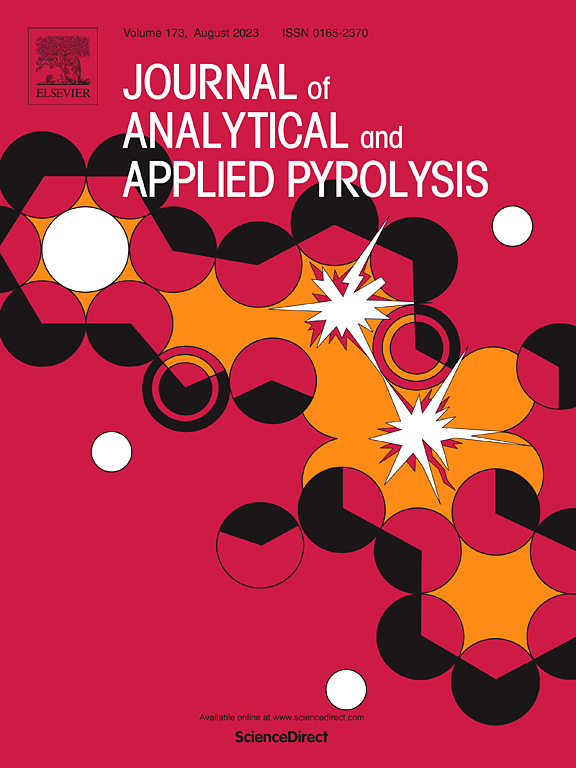Multi - scale perspective on hydrothermal treatment dewatering of lignite: Synergistic regulation of structural evolution and lightening of pyrolysis tar
IF 6.2
2区 化学
Q1 CHEMISTRY, ANALYTICAL
引用次数: 0
Abstract
Hydrothermal treatment dewatering (HTD) is a promising method for upgrading lignite. However, the mechanistic links between its structural modifications and the regulation of pyrolysis tar remain unclear. In this paper, the cascade effect of HTD on the physicochemical structure and pyrolysis tar components of lignite is systematically revealed by combining multi-scale characterization techniques (XPS, FTIR, BET) with Pyrolysis-Gas Chromatography/Mass Spectrometry (Py-GC/MS). The results show that the HTD process (330°C) can significantly reduce the moisture content (12.4 %→2.7 %) and oxygen content (38.00 %→31.89 %) of lignite. Moreover, the cleavage of O-containing groups and the decomposition of aliphatic chains drive the aromatization of organic structure during the HTD process. The XPS results show that the proportion of aromatic carbon content increased from 48.74 % to 70.85 %. These changes also directly affect the composition of the pyrolysis tar of lignite. The Py-GC/MS results indicate that the contents of aliphatic hydrocarbons and O-containing compounds in the tar continuously decrease with increasing HTD temperature, while the proportion of aromatic hydrocarbons significantly rises to 30.57 %. The content of phenolic compounds follows a non-linear trend, first increasing and then decreasing due to the hydrolysis and decomposition of hydroxyl functional groups. Additionally, the HTD process promotes the lightening of pyrolysis tar. For instance, the relative content of small-molecule aliphatic hydrocarbons (C4-C9) increases to 64.45 %, and the relative proportion of monocyclic aromatic hydrocarbons reaches 78.81 %. HTD is an effective method to improve quality of pyrolysis tar. The underlying mechanism is attributed to the synergistic effects of the distribution characteristics of functional groups, radical enrichment, and suppressed cross-linking. The research results provide key theoretical support for regulating the hydrothermal process of lignite and for preparing light tar with high added value.
褐煤水热脱水多尺度研究:热解焦油结构演化与减重的协同调控
水热脱水是一种很有前途的褐煤提质方法。然而,其结构修饰与热解焦油调控之间的机理联系尚不清楚。本文采用多尺度表征技术(XPS、FTIR、BET)和热解-气相色谱/质谱(Py-GC/MS)相结合的方法,系统揭示了HTD对褐煤理化结构和热解焦油组分的级联效应。结果表明:高温脱氢处理(330℃)能显著降低褐煤的含水率(12.4 %→2.7 %)和氧含量(38.00 %→31.89 %);此外,在HTD过程中,含氧基团的裂解和脂肪链的分解驱动了有机结构的芳构化。XPS结果表明,芳香族碳含量由48.74 %提高到70.85 %。这些变化也直接影响到褐煤热解焦油的组成。Py-GC/MS结果表明,随着高温加热温度的升高,焦油中脂肪烃和含氧化合物的含量不断降低,而芳香烃的含量显著上升至30.57 %。酚类化合物的含量由于羟基官能团的水解和分解,呈先增加后减少的非线性趋势。此外,HTD工艺促进了热解焦油的轻质化。其中,小分子脂肪烃(c4 ~ c9)的相对含量增加到64.45 %,单环芳烃的相对含量达到78.81 %。高温热解法是提高热解焦油质量的有效方法。其潜在机制是官能团分布特征、自由基富集和抑制交联的协同作用。研究结果为褐煤水热过程调控和制备高附加值轻焦油提供了关键的理论支持。
本文章由计算机程序翻译,如有差异,请以英文原文为准。
求助全文
约1分钟内获得全文
求助全文
来源期刊
CiteScore
9.10
自引率
11.70%
发文量
340
审稿时长
44 days
期刊介绍:
The Journal of Analytical and Applied Pyrolysis (JAAP) is devoted to the publication of papers dealing with innovative applications of pyrolysis processes, the characterization of products related to pyrolysis reactions, and investigations of reaction mechanism. To be considered by JAAP, a manuscript should present significant progress in these topics. The novelty must be satisfactorily argued in the cover letter. A manuscript with a cover letter to the editor not addressing the novelty is likely to be rejected without review.

 求助内容:
求助内容: 应助结果提醒方式:
应助结果提醒方式:


